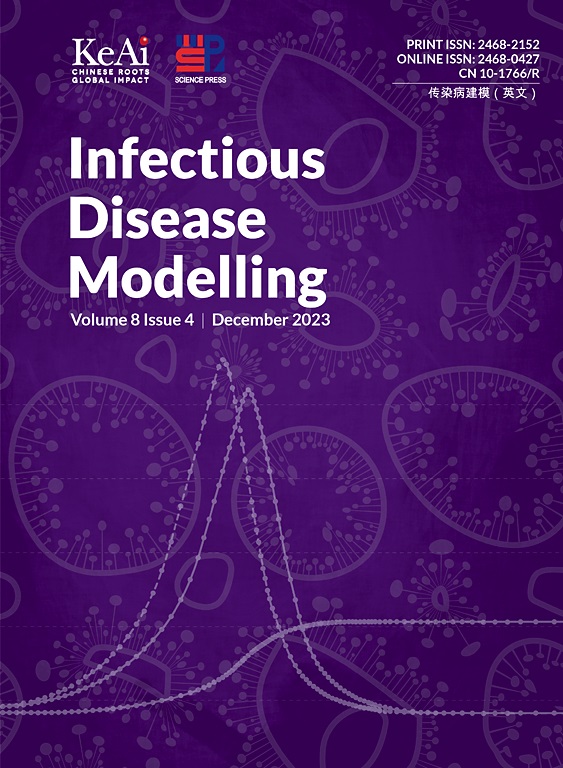Interactive effects of meteorological factors and ambient air pollutants on influenza incidences 2019–2022 in Huaian, China
IF 2.5
3区 医学
Q1 Medicine
引用次数: 0
Abstract
Background
Influenza is a global public health and economic burden. Its seasonality patterns differ considerably between geographic regions, but the factors underlying these differences are not well characterized.
Methods
The data on influenza were obtained from 2019 to 2022 in Huaian. A descriptive study was used to describe the epidemiological characteristics.The DLNM(distributed lag nonlinear model) model was established to further analyze the relationship between influenza cases, meteorological factors and pollutants. In addition, the attribution risk analysis and the interaction analysis further explored the interaction between the attributable risk and meteorological factors of influenza in terms of meteorological factors.
Results
A total of 9205 cases of influenza were reported in Huaian City from 2019 to 2022, Jiangsu province, of which 4938 cases were males and 4267 cases were females.The DLNM results showed an inverted U-shaped relationship between PM2.5(Fine Particulate Matter) and temperature and influenza.The low concentration of PM2.5 and O3(Ozone) showed decreased risks, and the maximum effect values appeared on the 8th day (RR(Relative Ris) = 0.35,95 %CI(Confidence Interval): 0.25–0.49) and the 2nd day (RR = 0.63,95 %CI: 0.52–0.77). At the high concentration, the cumulative RR values of PM2.5 and O3 reached their maximum on the 8th day (RR = 1.93,95 %CI: 1.47–2.54) and the 9th day (RR = 2.58,95 %CI: 1.63–4.09). The attribution analysis based on DLNM showed that the AF(attributable fraction) value of influenza attributable to the high concentration of PM2.5 exposure was 15.90 %, equivalent to 1456 cases. AF of the high concentration of O3 was 8.12 % (743 cases). The AF of low temperature effect was 30.91 % (2830 cases). The interaction analysis showed that high temperature reduced the influence of PM2.5 on the onset of influenza, showing an antagonistic effect (RR = 0.31, 95 %CI: 0.15–0.65), IRR(interaction relative risk) and RERI(interaction relative risk) were 0.17 (95 %CI: 0.08–0.37) and −1.62 (95 %CI: 2.65∼-0.68), respectively.
Conclusion
The results show that low temperature significantly increases the risk of influenza. At the low concentration of PM2.5, the risk of influenza increases with increasing concentration but decreases at the high concentrations. At the high concentration of O3, the risk of influenza increases rapidly. 15.90 % of influenza cases may be attributed to the high concentration of PM2.5, equivalent to 1456 cases; temperature-induced cases mainly come from the low-temperature effect, with an AF value of 30.91 %, equivalent to 2830 cases. In addition, high temperature can effectively mitigate the impact of PM2.5 on influenza incidence, and outdoor exposure time should be minimized in low temperature and high PM2.5 weather.
气象因子与大气污染物对淮安市2019-2022年流感发病的交互影响
流感是全球公共卫生和经济负担。其季节性模式在地理区域之间差异很大,但这些差异背后的因素并没有很好地表征。方法获取淮安市2019 - 2022年流感监测数据。采用描述性研究方法描述流行病学特征。建立DLNM(分布滞后非线性模型)模型,进一步分析流感病例、气象因素与污染物之间的关系。此外,归因风险分析和交互作用分析在气象因素方面进一步探讨了流感归因风险与气象因素之间的交互作用。结果2019 - 2022年江苏省淮安市共报告流感病例9205例,其中男性4938例,女性4267例。DLNM结果显示PM2.5(细颗粒物)与温度和流感呈倒u型关系。低浓度PM2.5和O3(臭氧)降低了风险,最大影响值出现在第8天(相对危险度RR = 0.35, 95% CI(置信区间)0.25 ~ 0.49)和第2天(RR = 0.63, 95% CI: 0.52 ~ 0.77)。高浓度时,PM2.5和O3的累积RR值在第8天(RR = 1.93, 95% CI: 1.47 ~ 2.54)和第9天(RR = 2.58, 95% CI: 1.63 ~ 4.09)达到最大值。基于DLNM的归因分析显示,PM2.5高浓度暴露导致的流感AF(归因分数)值为15.90%,相当于1456例。高浓度O3的心房颤动率为8.12%(743例)。低温效应AF为30.91%(2830例)。相互作用分析表明,高温降低了PM2.5对流感发病的影响,表现出拮抗作用(RR = 0.31, 95% CI: 0.15 ~ 0.65),相互作用相对风险(IRR)和相互作用相对风险(rei)分别为0.17 (95% CI: 0.08 ~ 0.37)和- 1.62 (95% CI: 2.65 ~ -0.68)。结论低温显著增加流感发病风险。PM2.5低浓度时,流感风险随浓度增加而增加,高浓度时降低。在臭氧浓度高的情况下,患流感的风险迅速增加。15.90%的流感病例可归因于PM2.5的高浓度,相当于1456例;温度诱发病例主要来自低温效应,AF值为30.91%,相当于2830例。此外,高温可有效缓解PM2.5对流感发病的影响,在低温、高PM2.5天气下应尽量减少室外暴露时间。
本文章由计算机程序翻译,如有差异,请以英文原文为准。
求助全文
约1分钟内获得全文
求助全文
来源期刊

Infectious Disease Modelling
Mathematics-Applied Mathematics
CiteScore
17.00
自引率
3.40%
发文量
73
审稿时长
17 weeks
期刊介绍:
Infectious Disease Modelling is an open access journal that undergoes peer-review. Its main objective is to facilitate research that combines mathematical modelling, retrieval and analysis of infection disease data, and public health decision support. The journal actively encourages original research that improves this interface, as well as review articles that highlight innovative methodologies relevant to data collection, informatics, and policy making in the field of public health.
 求助内容:
求助内容: 应助结果提醒方式:
应助结果提醒方式:


